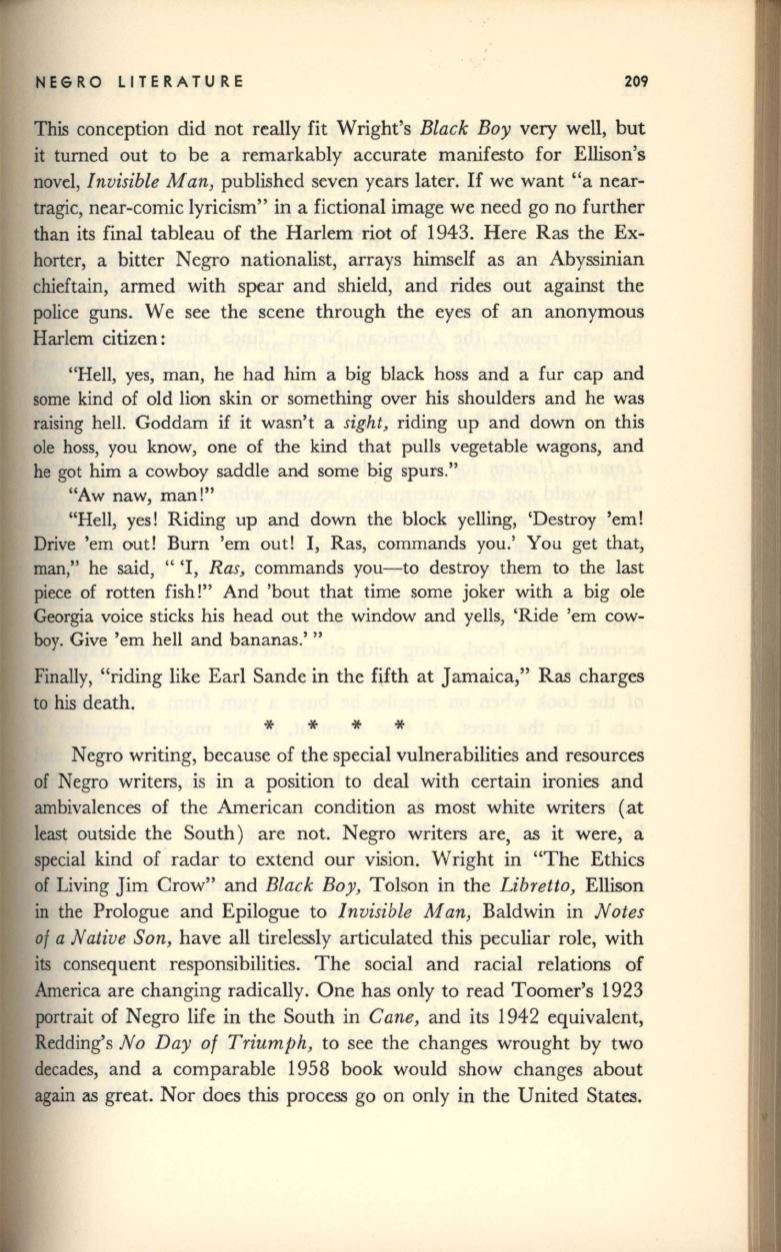
NEGRO LITERATURE
209
This
conception did not really fit Wright's
Black Boy
very well, but
it turned out to be a remarkably accurate manifesto for Ellison's
novel,
Invisible Man,
published seven years later.
If
we want "a near–
tragic, near-comic lyricism" in a fictional image we need go no further
than its final tableau of the Harlem riot of 1943. Here Ras the Ex–
horter, a bitter Negro nationalist, arrays himself as an Abyssinian
chieftain, armed with spear and shield, and rides out against the
police guns. We see the scene through the eyes of an anonymous
Harlem citizen:
"Hell, yes, man, he had him a big black hoss and a fur cap and
some kind of old lion skin or something over his shoulders and he was
raising hell. Goddam if it wasn't a
sight,
riding up and down on this
ole hoss, you know, one of the kind that pulls vegetable wagons, and
he got him a cowboy saddle and some big spurs."
"Aw naw, man!"
"Hell, yes! Riding up and down the block yelling, 'Destroy 'em!
Drive 'em out! Burn 'em out! I, Ras, commands you.' You get that,
man," he said, "'I,
Ras,
commands you-to destroy them to the last
piece of rotten fish!" And 'bout that time some joker with a big ole
Georgia voice sticks his head out the window and yells, 'Ride 'em cow–
boy.
Give 'em hell and bananas.' "
Finally, "riding like Earl Sande in the fifth at Jamaica," Ras charges
to
his
death.
*
* *
*
Negro writing, because of the special vulnerabilities and resources
of Negro writers, is in a position to deal with certain ironies and
ambivalences of the American condition as most white writers (at
least outside the South ) are not. Negro writers are, as it were, a
special kind of radar to extend our vision. Wright in "The Ethics
of Living Jim Crow" and
Black Boy,
Tolson in the
Libretto,
Ellison
in
the Prologue and Epilogue to
In visible Man,
Baldwin in
Notes
of a Native Son,
have all tirelessly articulated this peculiar role, with
its consequent responsibilities. The social and racial relations of
America are changing radically. One has only to read Toomer's 1923
portrait of Negro life in the South in
Cane,
and its 1942 equivalent,
Redding's
No Day of Triumph,
to see the changes wrought by two
decades, and a comparable 1958 book would show changes about
again
as great. Nor does this process go on only in the United States.


